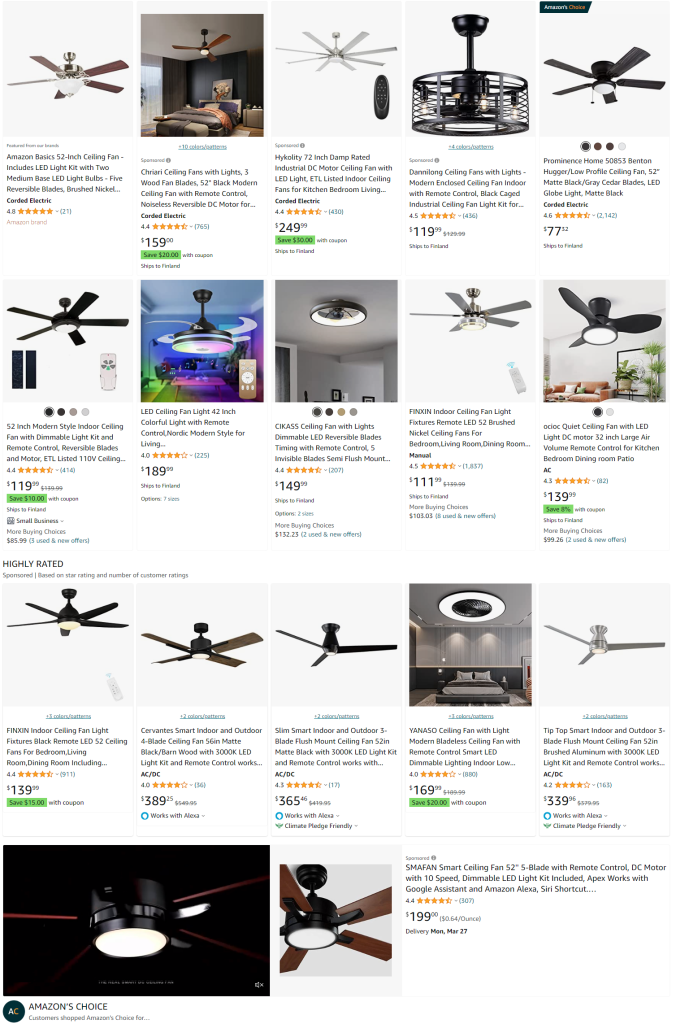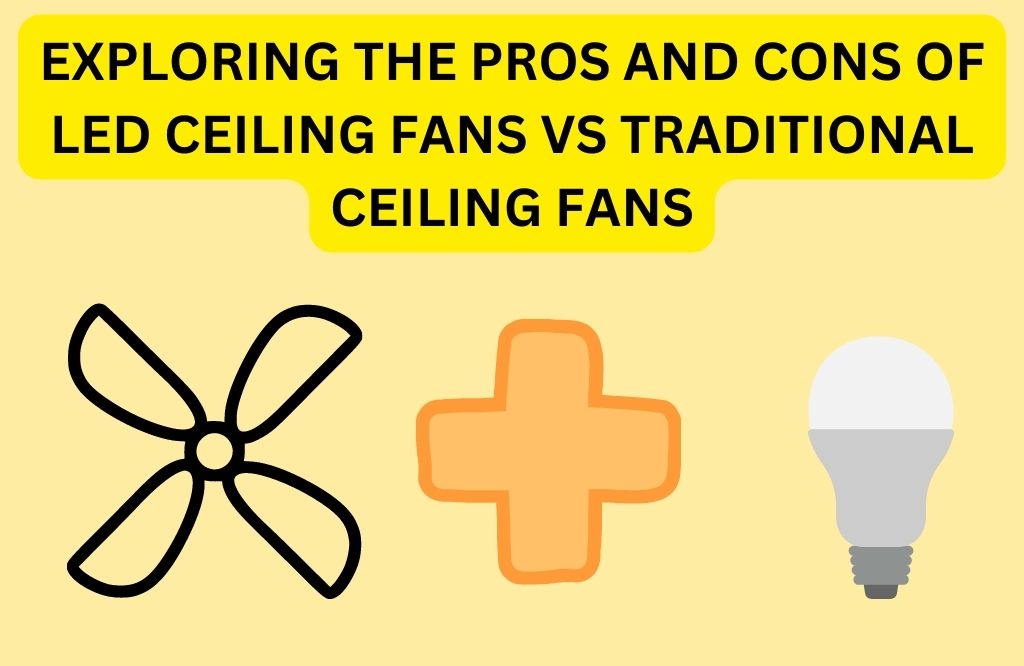Ceiling fans are a staple in many households and businesses, providing an efficient and effective way to circulate air and cool down a space. With the rise of LED technology, a new generation of ceiling fans has arrived, boasting greater energy efficiency and durability. In this article, we will delve into the differences between LED ceiling fans and traditional ceiling fans, carefully evaluating the advantages and disadvantages of each. This comparison will assist you in making a knowledgeable choice when choosing a new ceiling fan for your home or business.
| Key Takeaways |
|---|
| LED ceiling fans are more energy efficient and customizable, but can be more expensive and may have compatibility issues. |
| Traditional ceiling fans are more affordable and simple, but less energy efficient and require more frequent bulb replacements. |
| Consider your energy efficiency needs, lighting needs, personal style, and budget when choosing between LED and traditional ceiling fans. |
Defining LED Ceiling Fans and Traditional Ceiling Fans: Understanding the Differences
Before we dive into the details, it’s important to understand what sets LED ceiling fans apart from traditional ceiling fans. LED ceiling fans incorporate energy-efficient LED lighting into the design of the fan, while traditional ceiling fans do not. In other words, LED ceiling fans serve a dual purpose, providing both air circulation and lighting, while traditional ceiling fans only circulate air.
The Evolution of Ceiling Fans: A Brief History
To understand the differences between LED and traditional ceiling fans, it’s helpful to take a step back and examine the evolution of ceiling fans. While ceiling fans as we know them today have been around since the late 19th century, they have undergone significant changes and improvements over the years.
In their earliest incarnation, ceiling fans were powered by water or steam and were primarily used for industrial purposes such as cooling factories and warehouses. As electricity became more widely available, ceiling fans were adapted to run on electrical power, making them more accessible and practical for use in homes and businesses.
In the decades since, ceiling fans have become more efficient, quieter, and more customizable, with a wide range of styles, colors, and designs available to suit any taste or decor.

LED Ceiling Fans: The Benefits of Energy-Efficient Lighting
Now, let’s take a closer look at LED ceiling fans and the benefits they offer over traditional ceiling fans.
Understanding LED Technology: What You Need to Know
LED stands for “light emitting diode,” and refers to a type of lighting technology that uses a semiconductor to convert electrical energy into light. Compared to traditional incandescent bulbs, LED bulbs are far more energy efficient, using up to 80% less energy to produce the same amount of light.
In addition to their energy efficiency, LED bulbs also have a longer lifespan than traditional bulbs, with some models lasting up to 25,000 hours or more. This means that you’ll save money in the long run by not having to replace your bulbs as frequently.
The Advantages of LED Ceiling Fans: Improved Energy Efficiency and Longevity
So, what makes LED ceiling fans a better choice than traditional ceiling fans? Let’s take a closer look at some of the key benefits.
Energy Efficiency: Saving Money and Reducing Environmental Impact
One of the biggest advantages of LED ceiling fans is their energy efficiency. By incorporating LED lighting into the fan design, LED ceiling fans are able to provide both lighting and air circulation using a fraction of the energy required by traditional ceiling fans.
This translates to significant cost savings over time, as well as a reduced environmental impact. According to the U.S. Department of Energy, switching to LED lighting can reduce energy consumption by up to 75%, which can add up to significant savings on your energy bills.
Longer Lifespan: Getting More Bang for Your Buck
Another major advantage of LED ceiling fans is their longer lifespan. LED bulbs can last up to 25 times longer than traditional bulbs, which means you won’t have to replace them as frequently.
This is particularly important in the case of ceiling fans, which are often located in hard-to-reach places and can be difficult to replace. With an LED ceiling fan, you can enjoy years of efficient lighting and air circulation without having to worry about replacing bulbs or the fan itself.
Customizable Lighting Options: Creating the Perfect Atmosphere
In addition to their energy efficiency and longevity, LED ceiling fans also offer a wide range of customizable lighting options. Many LED ceiling fans come with dimming capabilities, allowing you to adjust the lighting to suit your needs and create the perfect ambiance in your space.
Some LED ceiling fans also come with color temperature adjustment features, which allow you to switch between warm, cool, and daylight settings to match your mood or activities.
Overall, LED ceiling fans offer a number of significant advantages over traditional ceiling fans when it comes to energy efficiency, longevity, and customization. However, they do come with a few drawbacks that are worth considering before making a final decision.
The Cons of LED Ceiling Fans: Cost and Compatibility
While LED ceiling fans offer many benefits, there are a few potential drawbacks to keep in mind.
Higher Upfront Cost: Making the Investment
One of the biggest drawbacks of LED ceiling fans is their higher upfront cost. Compared to traditional ceiling fans, LED ceiling fans can be significantly more expensive, which can make them less accessible for some consumers.
However, it’s important to remember that LED ceiling fans will ultimately save you money in the long run, as they are more energy efficient and have a longer lifespan than traditional fans. So, while the initial investment may be higher, you’ll likely recoup that cost over time through lower energy bills and fewer replacement costs.
Compatibility Issues: Ensuring the Right Fit
Another potential issue with LED ceiling fans is compatibility. LED bulbs are not always compatible with all ceiling fans, and in some cases, you may need to purchase specific LED bulbs or fans that are designed to work together.
It’s important to research the compatibility of any LED ceiling fan you’re considering before making a purchase, to ensure that you’re getting a product that will work with your existing electrical setup.
Traditional Ceiling Fans: A Tried and True Option
While LED ceiling fans offer a number of benefits, traditional ceiling fans are still a popular choice for many consumers. Let’s take a closer look at the pros and cons of traditional ceiling fans.
The Advantages of Traditional Ceiling Fans: Affordability and Simplicity
Traditional ceiling fans are a tried and true option that has been used for over a century to provide efficient air circulation and cooling. Some of the key advantages of traditional ceiling fans include:
Affordability: A Budget-Friendly Option
Compared to LED ceiling fans, traditional ceiling fans are generally more affordable, making them a great option for consumers who are on a tight budget.
Simplicity: A Straightforward Design
Traditional ceiling fans are also simpler in design than LED ceiling fans, which can be an advantage for consumers who prefer a more classic or understated look.
Easy Compatibility: A Wide Range of Options
Because traditional ceiling fans don’t incorporate LED lighting, they are generally compatible with a wider range of bulbs and fixtures, which makes it easier to find replacement parts or customize the lighting to your liking.
The Drawbacks of Traditional Ceiling Fans: Energy Inefficiency and Replacement Costs
While traditional ceiling fans offer some advantages, there are also a few potential drawbacks to consider.
Energy Inefficiency: Higher Energy Costs
Compared to LED ceiling fans, traditional ceiling fans are less energy efficient, which means they can be more expensive to operate over time.
Replacement Costs: Frequent Bulb Replacements
Traditional ceiling fans also require frequent bulb replacements, as traditional incandescent bulbs have a shorter lifespan than LED bulbs.
Overall, while traditional ceiling fans are a simpler and more affordable option, they do come with some potential drawbacks when it comes to energy efficiency and replacement costs.
Choosing the Right Ceiling Fan for Your Needs
When it comes to choosing between an LED ceiling fan and a traditional ceiling fan, there are a few key factors to consider.
First and foremost, think about your energy efficiency needs. If you’re looking to reduce your energy bills and decrease your environmental impact, an LED ceiling fan is likely the better option. LED ceiling fans are much more energy efficient than traditional fans, which can save you money in the long run.
However, if you’re on a tight budget and looking for a more affordable option, a traditional ceiling fan may be a better fit. While traditional fans are less energy efficient, they are generally more affordable upfront and require fewer compatibility considerations.
Another factor to consider is your lighting needs. If you’re looking for a ceiling fan that can provide both air circulation and lighting, an LED ceiling fan is the way to go. LED ceiling fans offer a range of customizable lighting options, making it easy to create the perfect ambiance in your space.
On the other hand, if you’re not as concerned about lighting and are just looking for a straightforward way to cool your space, a traditional ceiling fan may be a better choice.
Finally, consider your personal style and aesthetic preferences. LED ceiling fans tend to be more modern and sleek in design, while traditional ceiling fans have a classic and understated look. Think about what will fit best with the decor of your space and your personal sense of style.
Making a decision between an LED ceiling fan and a traditional ceiling fan ultimately comes down to your specific needs and preferences. By weighing the pros and cons of each option and considering your energy efficiency needs, lighting needs, and personal style, you can make an informed decision that will keep you cool and comfortable for years to come.
In conclusion, LED ceiling fans and traditional ceiling fans both offer advantages and disadvantages and choosing the right one for your needs depends on a variety of factors. LED ceiling fans are more energy efficient and offer customizable lighting options, but they also come with a higher upfront cost and potential compatibility issues. Traditional ceiling fans are more affordable and simpler in design, but they are less energy efficient and require more frequent bulb replacements. By considering your energy efficiency needs, lighting needs, personal style, and budget, you can make an informed decision and choose the ceiling fan that’s right for you.

